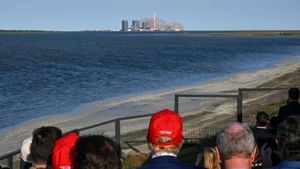Geopolitical tensions are simmering across Asia and the Pacific, especially as the United States maneuvers military assets closer to territories considered sensitive by China and Russia. Recent remarks from Russian Deputy Foreign Minister Sergey Ryabkov highlight Moscow's readiness to possibly deploy medium- and shorter-range missiles to the Asia-Pacific region if similar U.S. armaments are stationed there. This scenario is largely provoked by America's intentions, especially concerning the deployment of missiles to Japan’s southwestern islands and within the Philippines.
Ryabkov emphasized, "Of course, this is one of the options... The appearance of such U.S. systems will determine our next steps." He underscored the underlying tension by asserting, "what is happening depends entirely on the choice of our opponents at this extremely alarming moment." This highlights Moscow's view of geopolitical moves as direct communications, almost interpreted as chess pieces being placed on the board.
Meanwhile, Admiral Samuel Paparo, who heads the U.S. Indo-Pacific Command, weighed in by dissecting the increasing capabilities of the Chinese military. He noted this year’s extensive military rehearsals conducted by China, referring to them as the largest he has witnessed, indicating the pressing nature of these geopolitical rivalries. "This included on one day 152 vessels at sea... the largest rehearsal we've seen on an upward trend of PLA modernization," he stated at the Brookings Institution.
This precarious balancing act between military readiness and diplomatic solutions remains at the forefront of discourse for leaders deeply invested in the stability of the region. The recent actions from both sides serve to prevent potential escalations but also risks miscalculations or misunderstandings. Ryabkov mentioned Russia's current moratorium on the deployment of these missile types hinges on U.S. strategy, asserting, "we face no restrictions on deploying the Oreshnik medium-range ballistic missile under existing international obligations."
While the U.S. is focusing on establishing military bases and missile units primarily intended for contingencies surrounding Taiwan, China has conveyed its dissatisfaction. According to China's Foreign Ministry spokeswoman, Mao Ning, "Beijing firmly opposes countries using the Taiwan issue as pretext to increase military deployments, which only stirs up tensions." She emphasized the sentiment of maintaining regional stability, portraying America’s military build-up as provocative.
China's broader strategic view regards Taiwan as its breakaway province, and any perceived interference by the U.S. through military promotions only intensifies the Chinese stance against foreign influence. This resistance is reflected internally and externally, as China is not only deploying military resources but also rallying diplomatic support to counterbalance U.S. actions. Mao expressed appreciation for Russia's alignment with China's principles concerning Taiwan, reinforcing the notion of collaboration among nations viewing the U.S. role as aggressive.
Across this backdrop, it is apparent how Asia and the Pacific are shaping up as significant arenas of conflict with far-reaching consequences. This narrative draws observers and participants alike to assess their strategies. China's measures against perceived U.S. intervention include mobilizing military units and establishing operational frameworks. The recent military logistics laid out involve Japan's Self-Defense Forces aiding U.S. efforts, particularly with logistical support.
The discussions also highlight the intertwined fates of these nations, as Japan and the U.S. gear up for their first joint operational plan, projected to be developed next month. The collaboration symbolizes not just military preparedness but also strategic messaging to China about collective defense strategies.
International relationships are increasingly framed through the lens of military capabilities and geographical influence. The situation encapsulates rising anxieties, not only because of the technologies involved but also due to the urgent role these nations hold on the world stage, often defining their identities through their military prowess.
Beyond military buildups, the actions of states reflect cultural and historical contexts. China's emphasis on the one-China principle resonates deeply within its governance framework, informally tying its national identity with territorial claims and unity. Western narratives often miss these finer points, especially as U.S.-China relations remain strained under scrutiny.
Looking at the broader picture, as nations react to reversible tensions, the military posturing serves both as strategy and signal, matching words with actions, where geopolitical chess becomes ever more complex. Each piece moved can invoke responses from global stakeholders, amplifying their influence but risking outright conflict.
Pacific nations, now more than ever, are caught between superpowers with historical enmities. Where the specter of conflict looms, diplomacy remains the lifeblood of regional stability. Regular dialogues might just prove useful avenues to prevent misinterpretations on either side—akin to communications on the battlefield.



